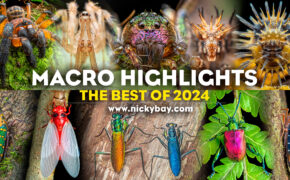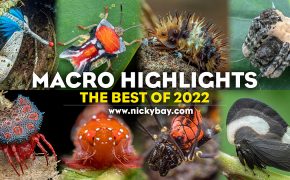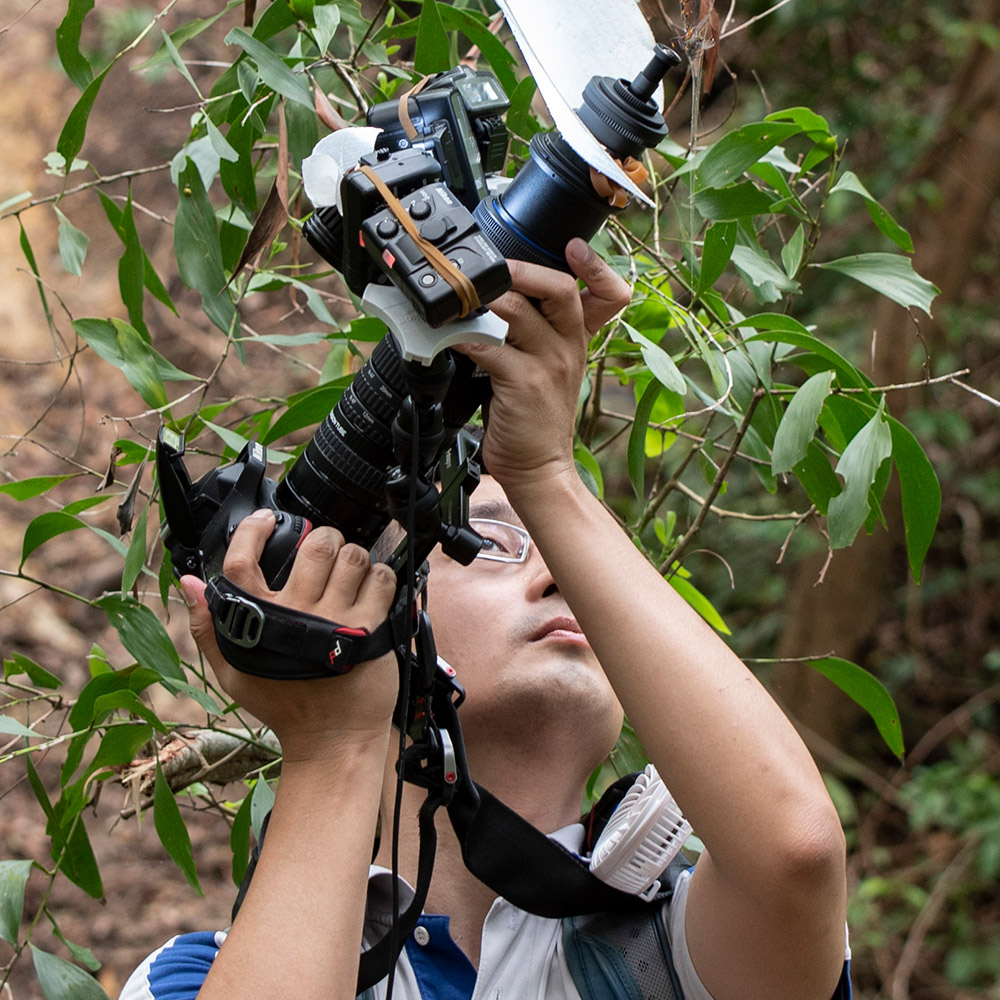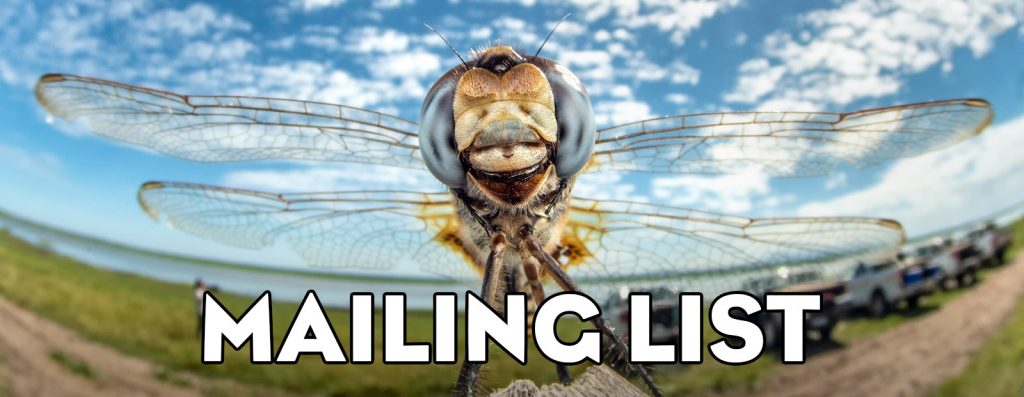Macro Highlights of 2012
As the year draws to an end, I looked back at my haul – over 3000 scenes captured and uploaded! This is a record as I put my tripod aside in June to embark on more hand-held adventures, chalking over 100 keepers in a day at times. I have also upgraded my camera to a Nikon D800, and switched back to a shorter lens – Tamron 90mm. I have also migrated to Flickr and started placing watermarks in the photos, due to several cases of misuse of my photos.
It is always difficult to select the best, so I’m adopting to showcase the best photos in a list of categories. 🙂 The photos have been chosen either for photographic quality or the beauty/rarity of the subject matter.
I would also like to take this opportunity to thank my fellow macro photographers who have been trudging forest trails and bashing out paths with me throughout the year, and sharing all the beautiful creatures uncovered with their amazing radars. You know who you are. 🙂
Fighting Spider (Thiania bhamoensis)
This beautiful Fighting Spider is lined by metallic scales of blue, with exceptionally large AMEs to boot!
Jumping Spider (Salticidae)
This photo appears here because of the details in the reflection of the spider’s eyes. I was covering my focusing light while taking this shot, and my fingers appeared in the reflection!
Malaysian Purple Femur Tarantula (Coremiocnemis sp.)
The Malaysian Purple Femur Tarantula is common at Fraser’s Hill, but rarely seen in the open!
Wandering Spider (Ctenidae)
A slightly different angle when viewing a wandering spider’s face up close
Bird Dung Crab Spider (Phrynarachne sp.)
A Bird Dung Crab Spider which lives it’s life looking like shit.
Huntsman Spider (Sparassidae)
A very large Huntsman Spider with unique tufts of hair on the legs. I didn’t have the right lens, and had to stitch 11 photos to get this shot!
Net-Casting Spider (Deinopis sp.)
This ogre-face spider has already captured it’s prey and reduced it to a small rubble
Lynx Spider (Oxyopidae)
My first shots with the MPE, kindly loaned from Victor. Turned out quite well except for my poor selection of settings which resulted in slight degradation of image quality.
Long Horned Orb Weaver (Macracantha arcuata)
The mother of all spiny back orb weavers!
Long-Legged Weevil (Curculionoidea)
Exceptionally long legs and snout of this weevil makes it unique.
Tiger Beetle (Neocollyris sp.)
The most vibrantly coloured Tiger Beetle that I have ever shot!
Stick Insect (Aschiphasma annulipes)
Jokingly called this the watermelon stick insect for the green streaks across the body!
Banded Flower Mantis (Theopropus elegans)
The Banded Flower Mantis has a uniquely shaped body with beautiful patterns.
Bark Horned Mantis nymph (Ceratocrania macra)
Bark Horned Mantis, sometimes mistaken to be the Devil’s Head Mantis for the devilish head!
Praying Mantis (Metallyticus splendidus)
A praying mantis (Metallyticus splendidus) which looks like it was made of a mish mash of coloured metal.
Lantern Bug (Pyrops candelaria)
Pyrops candelaria, product of Thailand
Lantern Bug (Pyrops sultana)
Pyrops sultana, common in Malaysia but still exotic looking!
Lantern Bug (Pyrops intricata)
Pyrops intricata, the only one I’ve seen with a yellow tipped snout
Millipede
This giant millipede has the most colourful set of legs that I have ever seen!
Harlequin Flying Frog (Rhacophorus pardalis)
Harlequin Flying Frog asking to have it’s pic taken. Why not?
Wagler’s Pit Viper (Tropidolaemus wagleri)
Adult Wagler’s Pit Viper lays at rest on a lazy morning
Fish Hook Ant (Polyrhachis bihamata)
These ants are armed with fish hooks on their back. Not the typical ant!
Armored Ant (Cataulacus sp.)
Tiny but bizarre looking armored ant. Almost missed this as it looked like any other ant until observed up close!
Dragon-Headed Katydid (Lesina sp.)
Dragon-Headed Katydid, look at all the crazy spikes!
Katydid (Tettigoniidae)
Face shots of the cone headed katydids can have pleasing compositions!
Ground Beetle (Carabidae)
Extremely difficult to illuminate due to the reflective surface. I had this entire ground beetle covered with my flashes!
Scarab Beetle (Cheirotonus sp.)
A pair of sexually dichromatic scarab beetles
Moth
Looking through the balcony glass door….
Wasps (Apocrita)
A wasp duo taking a break on a dangling branch
Cuckoo Bee (Thyreus sp.)
Sleeping beauty of a cuckoo bee
Orb Weaver Spider (Cyclosa sp.)
The Cyclosa orb weaver creates some of the most beautiful webs, next to the Neogea nocticolor (the latter’s decorated web is on my wish list)
Longhorn Beetle (Cerambycidae)
The moment before this longhorn beetle took flight, almost looking like some Gangnam Syle dance…!
Jewel Beetle (Endelus sp.)
Preflight also exposes what we rarely see beneath the wings. Sometimes, they look even more interesting inside!
Fireflies (Lampyridae)
A pair of fireflies making sure that our forests have that occasional flying glow
Robberflies (Asilidae)
Blue robberflies need not look at each other to make love
Water Striders (Gerridae)
Pond skaters in the process of multiplying
Water Measurers (Hydrometridae)
Water Measurers, super thin and tiny bugs that are almost impossible to focus on!
Striated Tylorida Spiders Mating (Tylorida striata)
These Striated Tylorida Spiders mate in public very often. In this shot, I tried to get all 16 eyes in focus!
Huntsman Spider (Sparassidae)
Savoring the moment as the female huntsman spider gets laid
Flesh Flies (Sarcophagidae)
Awkward moment when the male flesh fly slips and fumbles over the female’s eyes
Wolf Spider (Lycosidae)
Little wolf spiders climbing out of their egg sac and onto their mother’s abdomen where they will cling onto until they are big enough to hunt
Cellar Spider (Pholcidae)
Also known as Daddy Long Legs. Imagine a whole family of them emerging from the egg sac!
Wide Jawed Viciria (Viciria praemandibularis)
Just before the eggs of this Wide Jawed Viciria hatch, little white bits appear on each egg.
Forest Cockroach (Blattodea)
Scared of cockroaches? Try a fresh new brood of little ones. 100 of them?
Nursery Web Spider (Sphedanus sp.)
The nursery web spider bites onto her egg sac until the spiderlings are ready to hatch. Do they even eat during these weeks?
Huntsman Spider (Sparassidae)
The Huntsman Spider uses it’s palps to do the clinging job with a pillow-like egg sac.
Black Armoured Trapdoor Spider (Liphistius malayanus)
The trapdoor spider stays in it’s burrow all the time, and positions it’s legs at the entrance behind the trapdoor at night. Trip wires are built, radiating out from the trapdoor entrance to detect any unsuspecting prey passing by.
Thorn-Mimic Treehoppers (Membracidae)
We are thorns. Not treehoppers!
Tree Stump Orb Weaver (Heurodes porculus)
The tree stump orb weaver remains motionless on branches or stumps and looks exactly like part of the branch!
Kuhl’s Flying Gecko (Ptychozoon kuhli)
Even when observed up close, it was almost impossible to spot this pair of Kuhl’s Flying Geckos.
Ant-mimic Crab Spider (Amyciaea lineatipes)
Crab spider trying it’s best to mimic a red weaver ant and invite it over
Robberfly (Leptograstinae) capturing a Golden Orb Weaver (Nephilidae)
Vicious robberfly lands on the golden orb weaver’s web and rips it apart right in it’s own home!
Jumping Spider (Salticidae)
Cannibalism is not too uncommon with jumping spiders!
Crab Spider (Thomisidae)
Many cecidomyiid flies join the party while this crab spider sucks on it’s prey
Two-Tailed Spider (Hersilia sp.)
A documentation of a 9-minute moulting sequence of the Two-Tailed Spider.
Black and Golden Cicada (Huechys fusca)
100-frame animation of a moulting Cicada, awesome to watch!
Tiger Beetle-Mimic Katydid (Condylodera tricondyloides)
A katydid that pretends to be the ferocious tiger beetle. Check out the actual tiger beetle below to appreciate the mimicry.
Sawfly larva (Symphyta)
Sawfly larva, almost gummy-like!
Black and Golden Cicada (Huechys fusca)
Black and Golden Cicada moments after emerging from it’s moult. This colour remains only for a few minutes before it turns black.
Shield-Backed Bug (Scutelleridae)
The shield backed bug dons metallic colours both on it’s back and underside.
Jewel Beetle (Endelus sp.)
We could never leave out jewel beetles in this section, always a beauty!
Scorpion (Lychas scutilus?)
All-In-One. Scorpion with babies, with prey, under UV light and fill flash.
Millipede (Diplopoda) exhibiting UltraViolet Fluorescence
Quite an interesting scene with that many glowing legs moving in rhythm
Harvestman (Opiliones)
Even harvestmen! This was a recent discovery, so I would be taking more shots of harvestman under UV light in the coming year.
Water Boatman (Notonectidae)
Water Boatman resting beneath the water surface
Firefly larva (Lampyridae)
I have yet to shoot firefly trails, so I’ve started taking shots of light trails from their larva instead!
Bioluminescent Fungi (Mycena illuminans?)
Glowing mushrooms give a mystical feel, especially when they appear in large clusters.
Whip Scorpion (Thelyphonida)
Whip scorpion’s outline is highlighted with lights from everywhere but the front
Trilobite Beetle (Duliticola hoseini)
Back-lit trilobite larva
Eight Spotted Crab Spider (Platythomisus octomaculatus)
Spiders are ideal for back-lights when they have translucent parts!
Gray’s Leaf Insect (Phyllium bioculatum)
Gray’s Leaf Insect with all the details highlighted with back-lighting
Cicada (Cicadidae) with Jumping Spider (Salticidae)
A Jumping Spider hops onto the face of a Cicada, both oblivious to each others’ presence!
Jumping Spiders
The ever-popular jumping spiders are known for their cute and large Anterior Median Eyes (AME), and the most sought after shots have always been that of the eyes!


Tarantulas
The spiders with the worst reputation, but the hairy disposition has a certain allure of it’s own.

Wandering Spiders
Easy to photograph creatures, as they wouldn’t move much even when I’m 1 inch away from their faces.

Crab Spiders
Usually comes with a big face and small eyes, but more distinctly, lengthier fore-legs.

Huntsman Spiders
One of the most common nocturnal spiders in our parks, easily noticeable because of the large size.

Ogre-Faced Spiders
The characteristically gigantic eyes of the ogre-faced spider helps it to hunt at night. Direct shots of these eyes are a must!

Lynx Spiders
Common spiders in the bushes but without much well-taken shots.

Spiny Back Orb Weaver Spiders
The most common spiny back orb weaver would be the yellow Hasselt’s Spiny Back Orb Weaver. We do have several other unique spiny backs!

Weevils
Typical weevils look lazy and clumpy, and have a three dimensional shape, making it difficult to get the body in a single plane of focus.

Tiger Beetles
The fastest running living thing on land. Try catching one.

Stick Insects
These large arthropods usually come in dull brown colours, but there are always exceptions!

Mantises
Most have only seen the typical mantises in our parks. But there’s more!



Lantern Bugs
Undoubtedly one of the most sought-after subjects for macro lovers. I had the privilege to shoot 5 different species this year!



Millipedes
Often skipped macro subjects because of their size and relatively reflective body. It’s a challenge to capture these critters well!

Frogs
The usual frogs look drab, but tree frogs tend to show up in interesting and sometimes funny poses.

Snakes
The serpents of our land often hide from public view. A keen eye is all it needs to spot them!

Ants
Ants are all around us. Why should their pictures be highlighted? Because they can be just as awesome as the rest!


Katydids
Very common in our bushes. But some may actually look radically different!


Beetles
A beetle is just a beetle, no? Look harder!


Moths
Moths may look drab, but some can be beautifully decorated!

Wasps
With waists to die for, many skipped these subjects because of their flighty nature.

Bees
Another flighty group, but when they sleep.. almost nothing wakes them up!

Spider Webs

Preflight
Preflight is the split second when a beetle’s elytra (hard wings) open to unfold the hind wings in preparation for flight. Rarely shot and often breathtaking!


Mating Scenes
No mating scene should be passed up for any macro shooter. Call us porn directors or peeping toms if you must, but such scenes must always be captured in it’s raw beauty!







Motherly Love
Another must-shoot scene, would be of mothers tending to their young or eggs. The mothers often make extreme sacrifices in doing so!






Hunting Techniques
Not all spiders catch their prey on webs…

Camouflage
How to survive by blending into the background.



Predator-Prey Scenes
All part and parcel of survival in the wild. Almost every subject will get devoured or poisoned some day.




Best Sequences


Best Display of Mimicry
This section is a celebration of the best pretenders.


Best Display of Colours
Macro photographers are suckers for vibrant colours. Here’s a selection of some of the most beautifully coloured subjects.




Best of Ultra-Violet Fluorescence
Some creatures fluoresce under UV light. What crazy looking photographs could we capture, knowing that?



Best Underwater Scene
Who would’ve thought of shooting the little bugs that live beneath the water surface?

Best Glow-in-the-Dark Scenes
Several organisms glow in the dark. They provide excellent photographic opportunities!!


Playing with Lights
When the light does not come directly from the camera…




Strangest Scenes
They should not normally happen…

That’s it! I’m that bad at summarizing, but 2012 had so many exciting finds that dropping the selections became quite painful. lol.
To all macro photographers, here’s wishing everyone a bugful new year!















